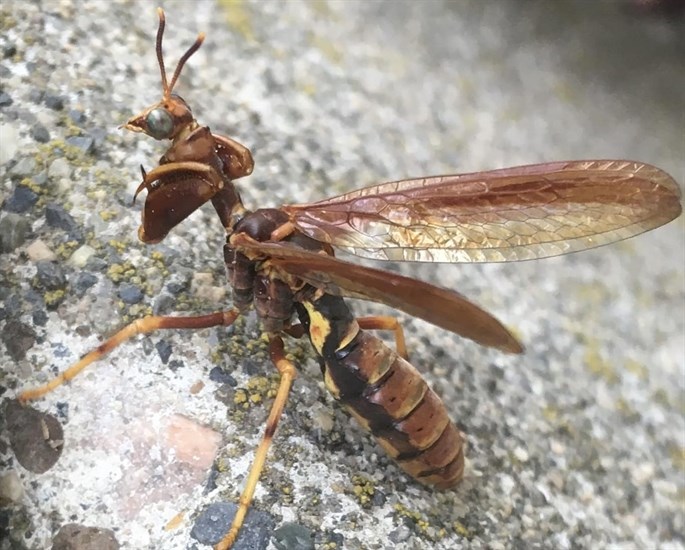
This wasp mantidfly was spotted at a residence in Kamloops on Oct. 8.
Image Credit: BT Giles
October 14, 2024 - 12:30 PM
A fascinating looking insect spotted on the front steps of a residence in Kamloops recently appears to be a cross between a praying mantis and a paper wasp, but it is neither.
Just over an inch long, the wasp mantidfly has a triangular head and large compound eyes with antennae that stick straight up. Its chunky forearms are similar to those of a praying mantis while its the strips on its body resemble those of a wasp.
But the wasp mantidfly isn’t a mantis or a wasp, it belongs to a group called neuroptera, or nerve-winged insects, and not only is it unusual looking, its behaviours are arguably even more so.
Wasp mantidfly larvae are spider parasites.
Upon hatching, a larva will wait for a passing spider and grab onto it where it feeds off the spider's blood until the spider lays eggs, according to the entomology department at the University of Minnesota.
If the larva is on a male spider it will move over to a female spider while the spiders mate, and as the eggs are laid the larva moves into the egg sac where it eats spider eggs until it pupates a year later.
READ MORE: Cleanup of what's left for Kamloops Red Bridge to continue through winter
The adult wasp mantidfly feeds on smaller insects including its own kind, and nectar and tree sap.
It can be found on vegetation or flowers waiting for prey which it holds with its powerful forelegs like a mantis while it eats.
The adult defends itself by curling its abdomen and moving back and forth, mimicking a stinging wasp, however it doesn’t have a stinger.
READ MORE: iN PHOTOS: Kamloops museum wool exhibit offers hands-on cultural experience
A male wasp mantidfly attracts a female using a pheromone and doing a courtship dance, raising its wings and extending its forelegs. Mating can take up to a day, where the male leaves a spermatophore on the female genitalia that she absorbs to fertilize her eggs.
Male mantidflies are short-lived and are typically only found in spring whereas the females live longer and can be spotted later in the year.
READ MORE: Penticton's new 'Turf Tank' robot needs a name
Wasp mantidflies can be found in the southern parts of British Columbia, Alberta, Manitoba, Ontario, and Quebec, throughout the United States, and into Mexico.
In areas where they are common, mantids reduce spider populations by eating spider eggs.
To contact a reporter for this story, email Shannon Ainslie or call 250-819-6089 or email the editor. You can also submit photos, videos or news tips to the newsroom and be entered to win a monthly prize draw.
We welcome your comments and opinions on our stories but play nice. We won't censor or delete comments unless they contain off-topic statements or links, unnecessary vulgarity, false facts, spam or obviously fake profiles. If you have any concerns about what you see in comments, email the editor in the link above. SUBSCRIBE to our awesome newsletter here.
News from © iNFOnews, 2024